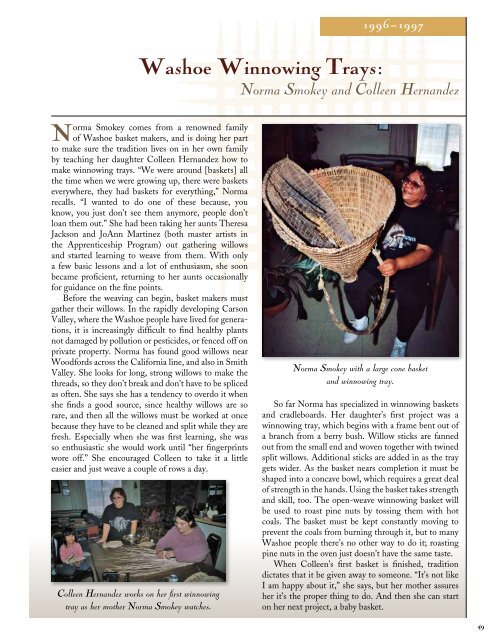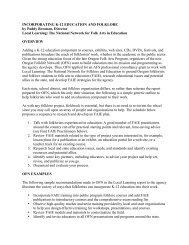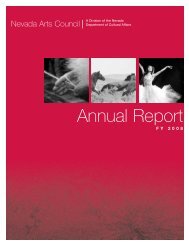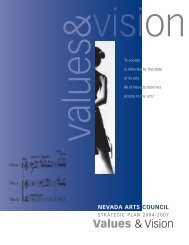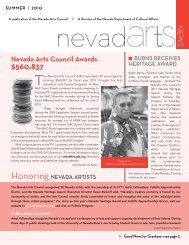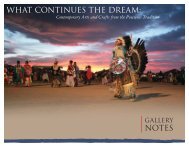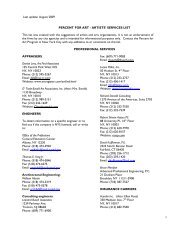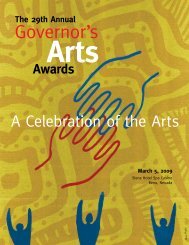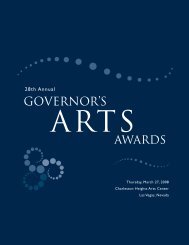Handed Down - Nevada Arts Council
Handed Down - Nevada Arts Council
Handed Down - Nevada Arts Council
You also want an ePaper? Increase the reach of your titles
YUMPU automatically turns print PDFs into web optimized ePapers that Google loves.
1996–1997<br />
Washoe Winnowing Trays:<br />
Norma Smokey and Colleen Hernandez<br />
Norma Smokey comes from a renowned family<br />
of Washoe basket makers, and is doing her part<br />
to make sure the tradition lives on in her own family<br />
by teaching her daughter Colleen Hernandez how to<br />
make winnowing trays. “We were around [baskets] all<br />
the time when we were growing up, there were baskets<br />
everywhere, they had baskets for everything,” Norma<br />
recalls. “I wanted to do one of these because, you<br />
know, you just don’t see them anymore, people don’t<br />
loan them out.” She had been taking her aunts Theresa<br />
Jackson and JoAnn Martinez (both master artists in<br />
the Apprenticeship Program) out gathering willows<br />
and started learning to weave from them. With only<br />
a few basic lessons and a lot of enthusiasm, she soon<br />
became proficient, returning to her aunts occasionally<br />
for guidance on the fine points.<br />
Before the weaving can begin, basket makers must<br />
gather their willows. In the rapidly developing Carson<br />
Valley, where the Washoe people have lived for generations,<br />
it is increasingly difficult to find healthy plants<br />
not damaged by pollution or pesticides, or fenced off on<br />
private property. Norma has found good willows near<br />
Woodfords across the California line, and also in Smith<br />
Valley. She looks for long, strong willows to make the<br />
threads, so they don’t break and don’t have to be spliced<br />
as often. She says she has a tendency to overdo it when<br />
she finds a good source, since healthy willows are so<br />
rare, and then all the willows must be worked at once<br />
because they have to be cleaned and split while they are<br />
fresh. Especially when she was first learning, she was<br />
so enthusiastic she would work until “her fingerprints<br />
wore off.” She encouraged Colleen to take it a little<br />
easier and just weave a couple of rows a day.<br />
Colleen Hernandez works on her first winnowing<br />
tray as her mother Norma Smokey watches.<br />
Norma Smokey with a large cone basket<br />
and winnowing tray.<br />
So far Norma has specialized in winnowing baskets<br />
and cradleboards. Her daughter’s first project was a<br />
winnowing tray, which begins with a frame bent out of<br />
a branch from a berry bush. Willow sticks are fanned<br />
out from the small end and woven together with twined<br />
split willows. Additional sticks are added in as the tray<br />
gets wider. As the basket nears completion it must be<br />
shaped into a concave bowl, which requires a great deal<br />
of strength in the hands. Using the basket takes strength<br />
and skill, too. The open-weave winnowing basket will<br />
be used to roast pine nuts by tossing them with hot<br />
coals. The basket must be kept constantly moving to<br />
prevent the coals from burning through it, but to many<br />
Washoe people there’s no other way to do it; roasting<br />
pine nuts in the oven just doesn’t have the same taste.<br />
When Colleen’s first basket is finished, tradition<br />
dictates that it be given away to someone. “It’s not like<br />
I am happy about it,” she says, but her mother assures<br />
her it’s the proper thing to do. And then she can start<br />
on her next project, a baby basket.<br />
49


